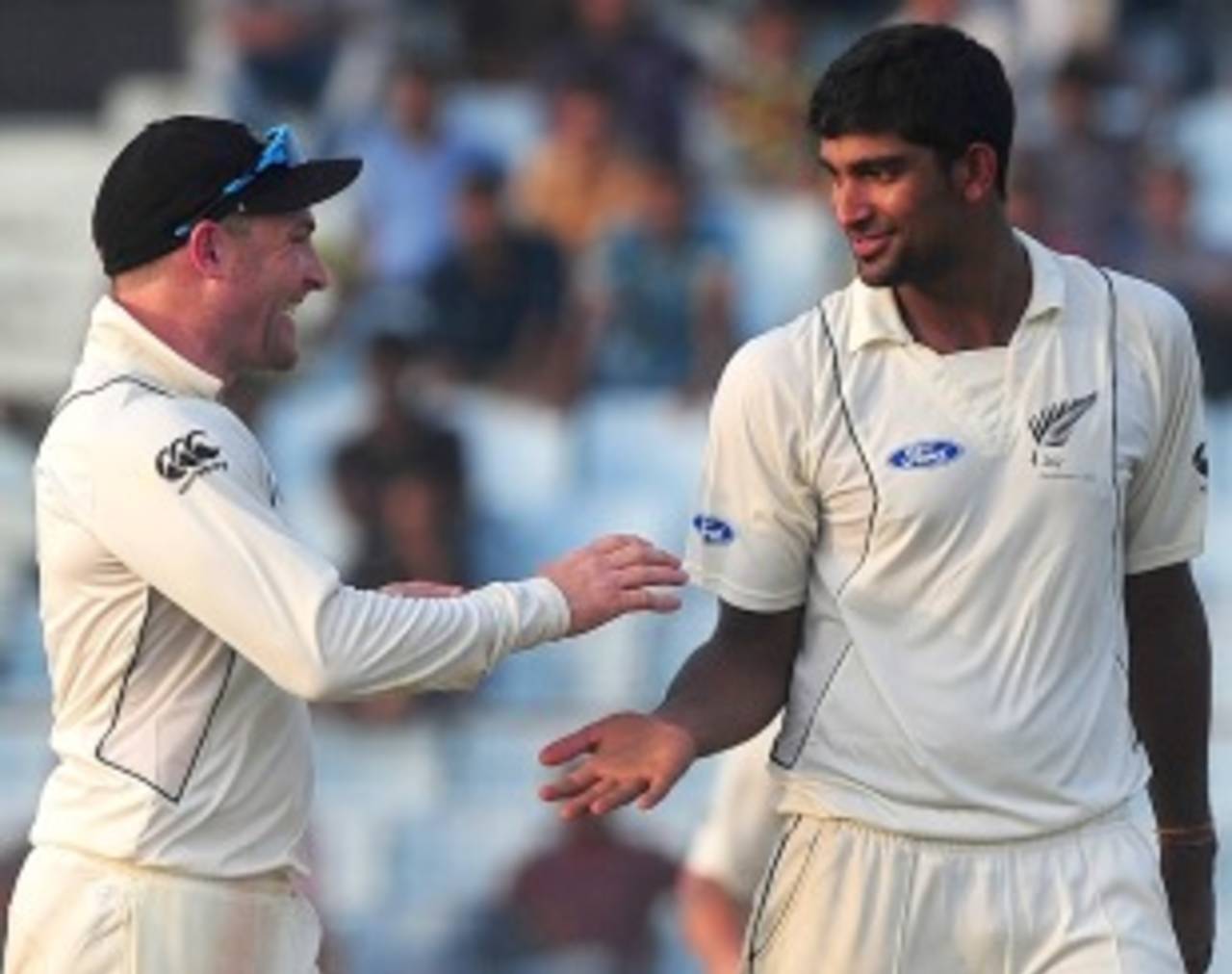Chittagong pitch helps no one
The batsmen got some batting practice, but otherwise it was soul-sapping stuff
Andrew Alderson
14-Oct-2013

New Zealand's spinners took only six of 13 wickets, while Bangladesh's spinners took 16 out of 17 • AFP
If it hadn't been for Brendon McCullum's bold declaration on the final day, Test No. 2097 would have been a contender for history's most drab.
Once Bangladesh posted 501 in reply to New Zealand's 469, the match seemed destined for a draw. Other four-letter "d" words might suffice - dull, dire, dead. Regardless of your choice, it was going to take an extraordinary set of circumstances to extract anything but a drawn verdict. The more cynical might extend the description to "drawn out". A couple of Bangladeshi players were even captured yawning when the New Zealanders emerged for their second innings. Can you imagine that happening in the Ashes?
New Zealand laid careful plans building towards this series. Several of the Test squad participated in an A tour to India and Sri Lanka to help them adjust to the subcontinent; others opted for a training camp in Sri Lanka, while the Otago contingent played in the Champions League. A shortcoming was the solitary washed-out warm-up match, but it was still better preparation than nothing ahead of last year's calamitous series through the West Indies, India and Sri Lanka.
Regardless of pre-match circumstances, attaining a result on a placid pitch looked a tough ask. The New Zealand pace bowlers exerted themselves for little reward on lifeless soil. Conversely, batsmen could stand and deliver. Peter Fulton even donned a white floppy hat, for goodness sake, while caps were de rigueur for a number of others.
International cricketers have to be capable of playing on any surface but looking at the barren tarmac of Chittagong, the New Zealand arsenal could be forgiven for pangs of despondency.
Thud. That was the sound heard for the majority of the Test, as Doug Bracewell and Trent Boult hit the pitch sheen with a roughed-up ball and it ballooned to the wicketkeeper. They got the odd one to zing with the newer ball - particularly when they pitched up - but it resembled the "strongman game" at a fairground; backs being bent for little reward.
The spinners got little purchase either. At times it looked like they were endeavouring to rip the ball off glass. Stealth was the watchword; sneak the ball past when the batsman has played through his shot or when he hits across the line.
Like McCullum's initiative, at least Bangladesh allrounder Sohag Gazi infused a touch of the unexpected as the first player to get a maiden Test century and a hat-trick in the same Test. He and fellow centurion Mominul Haque were the antidote to any mild bowling venom generated by the visitors in the first innings. They also used their feet well to the largely ineffectual Bruce Martin and Ish Sodhi. Both spinners opted for fuller rather than shorter length deliveries (nothing could have been worse than bowling short on that wicket), but it enabled the Bangladeshis to drive at will. Matters weren't helped when Martin dropped a caught-and-bowled off Gazi on 65 when Bangladesh were 439 for 8. Gazi and Robiul Islam posted an untroubled 105-run ninth-wicket stand despite having pre-Test averages south of 15. The low, slow wickets allowed batsmen to play without fear of pace or bounce. It was a case of wait for the ball and play it late.
Still, the New Zealand lower order showed pep too, with a 127-run tenth-wicket partnership between BJ Watling and Trent Boult. Another bonus for New Zealand was the solid opening stands between Hamish Rutherford and Fulton, who acquired some of the best batting practice they will get outside the nets. Rutherford, as has become customary, played several well-timed strokes through the covers in another abridged innings. Since his century on debut in Dunedin against England, he has had ten innings, six of which have seen him dismissed between 23 and 42. He's struggling to bat time.
Williamson shone with his fourth Test century in 26 Tests (and third on the subcontinent). He seemed to relish the extra time watching the ball on to the bat and compiling at will for 114 and 74. It was a skill that proved more vital than usual as the game went into slow motion. At times it was like bullet time in The Matrix.
Pre-match, McCullum had chuckled about the prospect of playing on a pitch bereft of grass. As a result, Sodhi's debut was never in doubt. He proceeded to show promise with his rhythm, loop and speed. If he can eliminate the one or two pressure-valve release four-balls each over he'll be a genuine threat.
McCullum must hope he will one day get to use the services of Daniel Vettori again in subcontinental conditions. Martin (2 for 175) and Sodhi (3 for 169) struggled to penetrate. Six of the 13 Bangladesh wickets were taken by spin compared to 16 of New Zealand's 17. Notably, when McCullum opted for spin in the second innings he went to part-timer Williamson first, followed immediately by Martin.
Vettori is a while away from being ready for the home summer as he rehabilitates from a June Achilles tendon operation in London. He will soon play club cricket.
The bigger solution on the pitch issue is for the ICC to invest in developing more balanced wickets with bounce and carry to help the Bangladesh game.
It's not like the pitch conditions did the hosts any favours. The ground has now hosted 11 Test matches since 2006 and produced eight results (all won by Bangladesh's opposition). The flipside is Bangladesh are struggling overseas on wickets contrasting dramatically to their own. Until that changes they will be anchored at No. 10 in the world rankings.
Andrew Alderson is cricket writer at New Zealand's Herald on Sunday